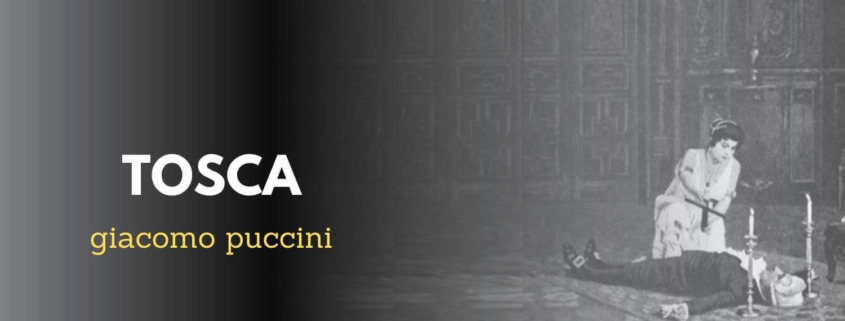VISSI D’ARTE – an aria from the opera Tosca
The online opera guide of Puccini’s aria VISSI D’ARTE
Read Interesting facts and hear great YouTube Videos about the famous Aria “Vissi d’arte”.
If you want to hear more about the opera Tosca, click on the link to the opera portrait
The aria – Synopsis & Background
Synopsis: Scarpia, the police chief, arrests Cavaradossi and lures Tosca to his house. Scarpia wants to conquer Tosca. He has Cavaradossi tortured in the presence of Tosca to reveal Angelottis hiding place. Scarpia offers Tosca to stop the torture for a night together. With this passage Puccini marks a turning point for the role of Tosca in the opera. Tosca has to bow to Scarpia to save Cavaradossi and turns to God. With the aria «Vissi d’arte», her personality changes for the audience. From a superficial, jealous actress, she becomes a woman whose suffering moves the listener.
Tosca is in an emotional state of emergency. She had to watch her lover Cavaradossi being abused in the torture chamber and hear the unspeakable threats and blackmail of Scarpia. These violent scenes trigger violent feelings. She reacts with disbelief. Why does God punish her who leads a pious life?
At the beginning of the aria Puccini writes the notation “pianissimo, dolcissimo, con grande sentimento”. The singer has to sing the beginning quietly, slowly and with a lot of feeling. After two lines, the mood changes in “Sempre con fé”. The belief in God changes the mood and the interpret has to change its expression into a beautiful melodious and intimate Singing.
Next comes a big beautiful crescendo on “diedi fiori”.
Then the mood changes again into the religious mood until the climax of the “perché, perché, Signor” which ends in the high B flat. This passage must sound expressive and yet noble because it is directed to God.
The Aria – the text of Vissi d’arte
Vissi d’arte, vissi d’amore,
non feci mai male ad anima viva!
Con man furtiva
quante miserie conobbi aiutai.
Sempre con fè sincera
la mia preghiera
ai santi tabernacoli salì.
Sempre con fè sincera
diedi fiori agl’altar.
Nell’ora del dolore
perché, perché, Signore,
perché me ne rimuneri così?
Diedi gioielli della Madonna al manto, e diedi il canto agli astri, al ciel,
che ne ridean più belli.
Nell’ora del dolor
perché, perché, Signor,
ah, perché me ne rimuneri così?
I lived for my art, I lived for love,
I never did harm to a living soul!
With a secret hand
I relieved as many misfortunes as I knew of.
Always with true faith
my prayer
rose to the holy shrines.
Always with true faith
I gave flowers to the altar.
In the hour of grief
why, why, o Lord,
why do you reward me thus?
I gave jewels for the Madonna’s mantle,
and I gave my song to the stars, to heaven,
which smiled with more beauty.
In the hour of grief
why, why, o Lord,
ah, why do you reward me thus?
Written for a «dramatic soprano»
The role of Tosca is written for a dramatic soprano. The dramatic soprano must have a strong, voluminous voice. The demand for vocal creativity is high, which is why these roles are usually entrusted to vocally mature and experienced singers. The role requires a high resilience and endurance of the singer.
Famous interpretations of Vissi d’arte
Tosca was one of Maria Callas’ absolute key roles with which she secured herself star fame and immortality.
Vissi d’arte (1) – Callas
Now you’ll hear Leontyne Price’s version. Next to Aida, Carmen and Leonora, Tosca was the role where she made the most impact.
Vissi d’arte (2) – Price
A very nice recording is with Giannina Arangi-Lombardi (1890-1951). She is singing at the same time very clear and yet very warm. A great pleasure!
Vissi d’arte (3) – Arangi-Lombardi
A fourth version from Angela Gheorghiu. Perhaps less dramatic, but more opulent.
Vissi d’arte (4) – Gheorgiu
Anna Netrebko gave her role debut as Tosca in 2018. And she did it right at the Met. The reviews were unanimously positive. She solved the difficult task of giving Tosca three different faces at each of the three acts. Listen to her in a lyrical version of «Vissi d’arte».
Vissi d’arte (5) – Netrebko
We hear another beautiful version from Renata Tebaldi. Kesting speaks of “a intensively surging singing and a B flat like a true signal rocket”.
Vissi d’arte (6) – Tebaldi
Peter Lutz, opera-inside, the online opera guide to the Aria “Vissi d’arte” from the opera TOSCA.




Leave a Reply
Want to join the discussion?Feel free to contribute!